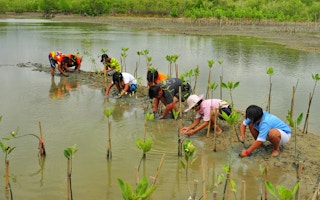Congresswoman Susan Yap, chair of the Philippines’ House of Representatives Reforestation Committee, is visiting Catanduanes, “the land of the howling winds”. The island is the most easterly in a country of over 7,000 islands, the landfall for storms sweeping in from the Pacific, and therefore highly vulnerable.
“The Philippines is one of the most disaster-prone countries in the world”, says Yap. “We have several typhoons every year, but in the last five years we’ve seen an increase of about 30 per cent. We are having 25 to 28 typhoons a year. Even their strength is much more, with winds of over 300 km per hour.”
Widespread deforestation has not helped. Over the 20th century national forest cover fell from 70 per cent to 20 per cent. It is currently declining at two per cent annually. Without it topsoil is lost and flash floods increase in intensity.
The government’s response is its biggest environmental project, the National Greening Program. But there are concerns over its effectiveness, and Yap intends to find out more. “As a legislator it is my duty to make sure that government projects are implemented well”, she says.
Our TVE crew followed the committee from the House of Representatives to the mangroves of Catanduanes, crucial to protection against the typhoons. Mangroves are important not only to fisheries but to coasts and can reduce the impact of wave height by half over 100 m.
“
Out of the 1bn pesos [US$23m] allocated for mangrove reforestation after typhoon Yolanda (Haiyan), some should have been allocated for research about mangroves
Captain Ivanhoe Arcilla, a former fighter pilot turned local disaster risk reduction and prevention officer
Think first
But at one of the Greening Program’s sites newly planted propogules (long single stems which the mangrove drops in order to reproduce) have been infested by barnacles. Considerable manpower has been used to clean the stems repeatedly but, as the committee points out, it would have been better spent planting in areas free from barnacles to begin with.
“Visiting the people in these places I have learnt that there is lack of funding for these projects and their implementation remains a challenge, so getting on the ground keeps our government people on their toes and makes them realise that hey, we are serious about this work”, Yap says.
Taking us round the mangrove sites, Captain Ivanhoe Arcilla, a former fighter pilot turned local disaster risk reduction and prevention officer, sums up his frustration: “Out of the 1bn pesos [US$23m] allocated for mangrove reforestation after typhoon Yolanda (Haiyan), some should have been allocated for research about mangroves.”
The centrepiece of the committee’s visit to Catanduanes was the public consultation meeting, a novelty in a country where people are unused to being consulted. It was an eye-opener, helping local congressman and fellow committee member Cesar Sarmiento draft legislation for later in the year.
Public voice
“The public consultation was the first in Catanduanes and some citizens shared their experiences”, he told us. “This is the information that’s needed by the committee, to fine tune and come up with legislation that can be effectively implemented.”
“This is the best thing, I mean this public hearing about mangroves and reforestation and all that, it’s the best thing that’s happened here in Catanduanes”, said Capt. Arcilla.
Legislators from 100 countries are meeting in Mexico for Globe International’s second World Summit of Legislators. Their immediate aim is to encourage countries to enact legislation to cut greenhouse gas emissions in the run-up to the comprehensive climate agreement which UN talks in Paris late in 2015 are intended to produce.
Yap says Catanduanes’ “bottom up” approach and the sharing of information chime with her membership of Globe: “I believe that Globe can assist a country like the Philippines in communicating within the international community to set up the framework for local legislators. Together we can find solutions and partnerships for having a low carbon green economy in the Philippines.”
And above all, when agreements are in place, oversight can ensure their effective operation: “Globe believes that legislators are accountable for the policies we’ve passed. Oversight and holding our executive and governments accountable for the work we’re doing is crucial.”










